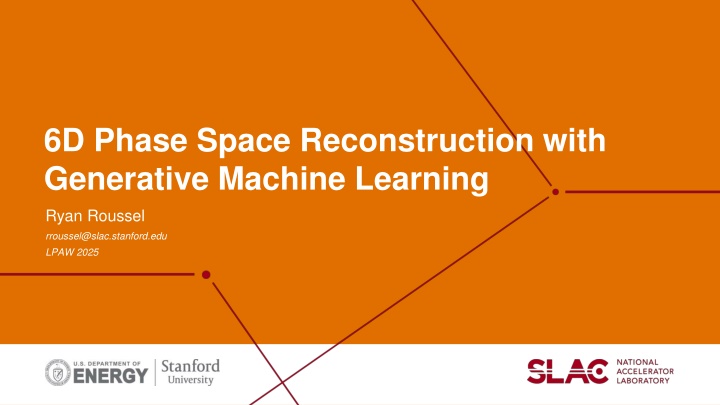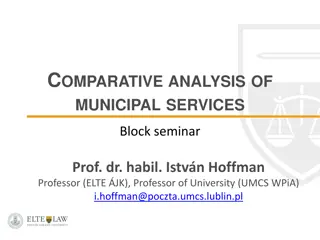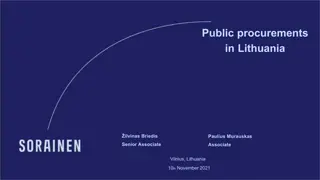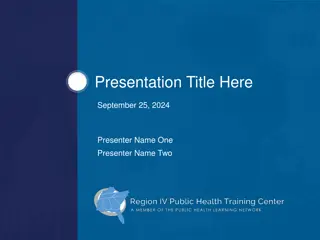
Efficient 6D Beam Distribution Reconstruction with Machine Learning
Explore modern challenges in beam diagnostics and learn about advanced techniques like machine learning-based virtual diagnostics and directly measuring 6D beam distributions. Understand the difficulties scaling conventional tomography to 6D and discover optimization methods for inferring beam distributions. Enable efficient 6D reconstructions using generative machine learning for complex beam structures.
Download Presentation

Please find below an Image/Link to download the presentation.
The content on the website is provided AS IS for your information and personal use only. It may not be sold, licensed, or shared on other websites without obtaining consent from the author. If you encounter any issues during the download, it is possible that the publisher has removed the file from their server.
You are allowed to download the files provided on this website for personal or commercial use, subject to the condition that they are used lawfully. All files are the property of their respective owners.
The content on the website is provided AS IS for your information and personal use only. It may not be sold, licensed, or shared on other websites without obtaining consent from the author.
E N D
Presentation Transcript
6D Phase Space Reconstruction with Generative Machine Learning Ryan Roussel rroussel@slac.stanford.edu LPAW 2025
Modern Challenges in Beam Diagnostics Beam shaping for high efficiency PWFA Modern accelerator applications require precise understanding of high dimensional beam structure ? ? = ?,??,?,??,?,?? RMS quantities Exact beam structure C. A. Lindstr m, et al. Phys. Rev. Lett. 126, 014801 Laser Wakefield Acceleration ?? ?? Vay, J-L., et al. NIMA 909 (2018): 476-479. 2
Machine Learning-Based Virtual Diagnostics Use ML to represent complex relationships between accelerator parameters and simulated / experimental measurements non-destructive measurements A.L. Edelen et al., IPAC18, THYGBE2 C. Emma et al, Instruments (2021) A. Scheinker Sci. Reports 14.1 (2024): 29303. Requires detailed knowledge of system dynamics and/or large data sets to accurately predict measurements as a function of accelerator parameters. 3
Directly Measuring 6D Beam Distributions Multiple scanning slits with dipole and bunch shape monitor @ SNS (ORNL) 5D tomography with polarizable X-band TDC @ ARES (DESY) Jaster-Merz, S., et al Proc. IPAC 22 (2022): 279-283. Cathey, Brandon, et al. PRL 121.6 (2018): 064804. 960 measurements ~ 28 hrs Tomographic reconstruction ~ 24 hrs 5 million (!) measurements ~ 32 hrs 4
Difficulties Scaling Conventional Tomography Analysis to 6D Information compression Costs of detailed beam representations 2D image 6D distribution Histogramming scales poorly with number of dimensions, ????? ?? {< ? >,??} Reasonable resolution, ? = 100 For a 6D distribution, ?????= 1012! Scalar values 1D projection(s) Often required by analysis constraints (analytical tractability, optimization simplicity, etc.) 5
Inferring Beam Distributions Using Optimization Solve an optimization problem: 1. Parameterize an initial beam distribution 2. Simulate beam dynamics to predict measurements 3. Adjust initial beam distribution to match predictions to measurements 6
Enabling Efficient 6D Reconstructions (2) Implement differentiable beam dynamics simulations to enable learning (1) Use generative machine learning to represent complex 6D beam distributions. 7
Generative Beam Representations Use a generative machine learning model to create arbitrary beam distributions Example: arrange particles to make the SLAC logo O(~1000) parameters of the neural network control the distribution of particles in 6D phase space Learn the beam distribution by optimizing the NN parameters 8
Enabling Efficient 6D Reconstructions (2) Implement differentiable beam dynamics simulations to enable learning O(~1000) parameters 9
Differentiable Beam Dynamics in Cheetah Differentiable beam dynamics simulation (written in PyTorch) Gonzalez-Aguilera, J., et al. Proc. IPAC 23 (2023): 1725-1729. Cheetah collaboration between DESY, SLAC, LBNL, UChicago, KIT https://github.com/desy-ml/cheetah J. Kaiser, et.al. Phys. Rev. Accel. Beams 27, 054601 (2024) 10
Generative Phase Space Reconstruction (GPSR) Now we can use gradient descent to optimize (train) beam parameters necessary for learning O(~1000) parameters Roussel, Ryan, et al. PRL (2023) 11
Reconstructing 4D Beam Distributions from Quadrupole Scans Reconstructed distribution Magnetized beam scan Proof of concept reconstruction from quadrupole scan @ AWA Roussel, R, et al. PRL (2023) FACET-II Quadrupole Scan (Online GPSR analysis < 1 min) Kim, S., et al. PRAB (2024) 12
Extension to 6-Dimensional Reconstructions Add longitudinal diagnostics to basic quadrupole scan: Training data: Roussel, R., et al. PRAB (2024) 13
Reconstruction Predictions Evaluate reconstruction accuracy: Compare reconstruction predictions with test data Predicted Measured Roussel, R., et al. PRAB (2024) 14
6-Dimensional Reconstruction of Beams at AWA Reconstructed 6D distribution Measurement: ~8 mins Training: ~16 mins 30 hrs 24 mins: 75x faster than previous measurements ML Reconstructions from scratch, no pretraining or prior data required! Roussel, R., et al. PRAB (2024) 15
Conclusion GPSR enables 6D reconstructions using small datasets (< 20 measurements), no prior model training required! GPSR enables substantial improvements in analysis capabilities that can benefit our understanding of beam dynamics + high dimensional structure of beam distributions Available for use right now: https://github.com/roussel-ryan/gpsr pip install gpsr 17
Questions? SLAC - - - - - - - U. Chicago - Juan Pablo Gonzalez-Aguilera Argonne Wakefield Accelerator - Seongyeol Kim - John Power - Eric Wisniewski - Wanming Liu - Alexander Ody Auralee Edelen Chris Mayes Daniel Ratner Doug Storey Nathan Majernik Brendan O Shea Claudio Emma Thanks to the team! 18
Backup 19
Addressing Beam Jitter Heuristic: Center beam on screen for each shot using centroid measurement Pros: - Straightforward to implement Cons: - Cannot reconstruct centroid offset of 6d dist. - Assumes no shot-to-shot variance in distribution Currently used for analysis Formal: Variational inference (VI) / Hamiltonian Monte Carlo (HMC) Pros: - Isolates distribution of centroid jitter Cons: - Requires additional R&D - Assumes no shot-to-shot variance in distribution (so far) 20
Uncertainty Quantification via Ensembling FACET-II injector reconstructions using ensembling heuristic 21






















